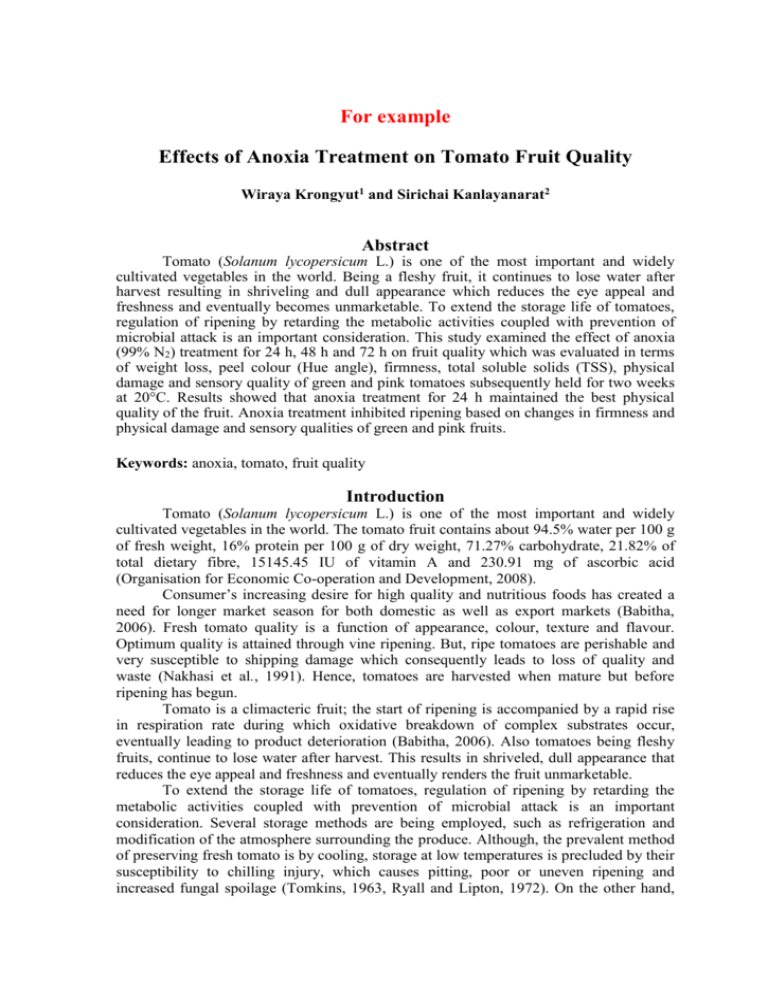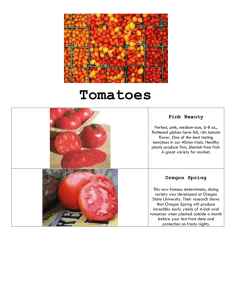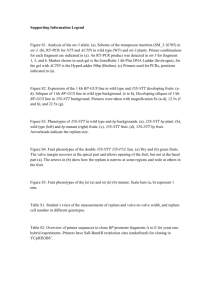of the example of full paper
advertisement

For example Effects of Anoxia Treatment on Tomato Fruit Quality Wiraya Krongyut1 and Sirichai Kanlayanarat2 Abstract Tomato (Solanum lycopersicum L.) is one of the most important and widely cultivated vegetables in the world. Being a fleshy fruit, it continues to lose water after harvest resulting in shriveling and dull appearance which reduces the eye appeal and freshness and eventually becomes unmarketable. To extend the storage life of tomatoes, regulation of ripening by retarding the metabolic activities coupled with prevention of microbial attack is an important consideration. This study examined the effect of anoxia (99% N2) treatment for 24 h, 48 h and 72 h on fruit quality which was evaluated in terms of weight loss, peel colour (Hue angle), firmness, total soluble solids (TSS), physical damage and sensory quality of green and pink tomatoes subsequently held for two weeks at 20°C. Results showed that anoxia treatment for 24 h maintained the best physical quality of the fruit. Anoxia treatment inhibited ripening based on changes in firmness and physical damage and sensory qualities of green and pink fruits. Keywords: anoxia, tomato, fruit quality Introduction Tomato (Solanum lycopersicum L.) is one of the most important and widely cultivated vegetables in the world. The tomato fruit contains about 94.5% water per 100 g of fresh weight, 16% protein per 100 g of dry weight, 71.27% carbohydrate, 21.82% of total dietary fibre, 15145.45 IU of vitamin A and 230.91 mg of ascorbic acid (Organisation for Economic Co-operation and Development, 2008). Consumer’s increasing desire for high quality and nutritious foods has created a need for longer market season for both domestic as well as export markets (Babitha, 2006). Fresh tomato quality is a function of appearance, colour, texture and flavour. Optimum quality is attained through vine ripening. But, ripe tomatoes are perishable and very susceptible to shipping damage which consequently leads to loss of quality and waste (Nakhasi et al., 1991). Hence, tomatoes are harvested when mature but before ripening has begun. Tomato is a climacteric fruit; the start of ripening is accompanied by a rapid rise in respiration rate during which oxidative breakdown of complex substrates occur, eventually leading to product deterioration (Babitha, 2006). Also tomatoes being fleshy fruits, continue to lose water after harvest. This results in shriveled, dull appearance that reduces the eye appeal and freshness and eventually renders the fruit unmarketable. To extend the storage life of tomatoes, regulation of ripening by retarding the metabolic activities coupled with prevention of microbial attack is an important consideration. Several storage methods are being employed, such as refrigeration and modification of the atmosphere surrounding the produce. Although, the prevalent method of preserving fresh tomato is by cooling, storage at low temperatures is precluded by their susceptibility to chilling injury, which causes pitting, poor or uneven ripening and increased fungal spoilage (Tomkins, 1963, Ryall and Lipton, 1972). On the other hand, the use of very low levels of O2 or high levels of CO2 has been tested as a means of postharvest quality maintenance (Ke and Kader, 1992). However, commodities differ in their tolerance to reduced O2 and/or elevated CO2. Keeping fruit and vegetables in a very low oxygen atmosphere (anoxia) may have beneficial effects, such as reduction in respiration rate, inhibition of ethylene production and action, and reduction of the incidence of some physiological disorders (Ke and Kader, 1992; Pesis et al., 1994). Several other researchers have found that pretreatment with anoxia can delay fruit ripening (Lurie and Pesis, 1992; Pesis and Marinansky, 1993; Burdon et al., 1994). Fallik et al. (2003) added that a short-term anoxia treatment (for 24 h) significantly reduced rot development in tomato inoculated with Botrytis cinerea, compared to non-treated fruit. However, a 48 h anoxia treatment reduced fruit quality, damaged the fruit, and caused off flavor. Off-flavor development has been attributed to ethanol accumulation (Kelly and Salviet, 1988). These findings suggest that the efficacy of anoxia treatment depends upon the length of application and type of produce. This study was conducted to evaluate the effects of different durations of anoxia treatment on the physical and sensory quality of green and pink tomatoes. Materials and Methods Green and pink tomatoes cv. 1912 of uniform size and colour and without any defects were harvested from a commercial non-heated plastic house from the central part of Israel. The calyx was removed from each fruit. The tomatoes were weighed. Fruit color was obtained using a Minolta Chromameter, total soluble solids (TSS) using a digital refractometer (Atago, Japan), and firmness using a durometer (firmness gauge, Shore Brothers, USA). Fifteen green and pink tomatoes were selected and placed inside three 25 L plastic containers and treated with 99% N2 for 24 h, 48 h and 72 h. Lime was introduced to the containers to absorb CO2. Fruits without anoxia treatment served as control. All treatments were replicated three times. Following each treatment, fruits were removed from the containers and stored for two weeks at 20°C with 70% RH. Fruit quality during storage was evaluated in terms of weight loss, colour (Hue angle), firmness, TSS and taste. Anoxia damage was determined visually and expressed as percentage of the total number of samples per replicate. Sensory analysis was performed by 6 untrained panelists. Fruit were cut into six pieces and placed on dark glass dishes. Flavour was scored on a scale of 1-3, with: 1-bad, 2-good and 3-excellent. Off-flavour was evaluated on a scale of 0-3, with: 0-no offflavour, 1-slight off-flavour, 2-moderate off-flavour and 3-strong off-flavour. At the end of the sensory analysis, panelists indicated their preferred sample. Results were analysed using Microsoft Excel Results and Discussion Anoxia treatment for 48-72 h significantly increased weight loss of green and pink tomatoes after two weeks of storage; as 24 h treatment, anoxia had no significant effect (Table 1). Color changes based on hue values did not differ with treatment and generally decreased with storage in both green and pink tomatoes (Table 2). However, fruit firmness significantly varied; for green fruits, all anoxia treatments maintained firmer fruits than the control while for pink fruits, only the 24 h anoxia treatment resulted in significantly firmer fruits than the control after 2 weeks of storage (Table 3). In terms of TSS contents, anoxia had no marked effect on green tomatoes while it significantly increased that of pink tomatoes particularly when applied for 24-48 h (Table 3). In both green and pink tomatoes, anoxia treatment for 48-72 h increased physical damage and off-flavor development, decreased taste scores, and consequently reduced the overall acceptability in both green and pink tomatoes (Table 4-5). In contrast, anoxia for 24 h generally resulted in comparable responses as the untreated control, except that the overall acceptability for green tomatoes was improved. The results indicate that anoxia for 24 h had no adverse effects on quality of green and pink tomatoes; it even improved soluble solids content of pink tomatoes. The treatment appeared to slow ripening by maintaining firmer fruits after two weeks of storage, although this was not accompanied by a corresponding reduction in the rate of ripening-associated color changes as found in earlier studies (Lurie and Pesis, 1992; Pesis and Marinansky, 1993; Burdon et al., 1994). Longer duration of anoxia treatment (e.g. 48 h) could damage the fruit and induce off-flavors as a result of ethanol accumulation (Fallik et al., 2003; Kelly and Salviet, 1988). This has also been found in the present study with the use of 48-72 h anoxia. Table 1 Weight loss (% of initial weight) of anoxia-treated and untreated green and pink tomatoes after 14 days of storage Anoxia Treatment Green fruit Pink fruit c 0 (Control) 4.4 5.1b 24 h 4.7bc 5.1b a 48 h 5.6 6.4a 72 h 5.1ab 4.9b F-test ** ** CV (%) 4.73 1.32 Mean separation within columns by LSD (P ≤ 0.05) Table 2 Colour (Hue angle) of anoxia-treated and untreated green and pink tomatoes after 14 days of storage Green fruit Pink fruit Anoxia After 2 weeks After 2 weeks Treatment Before storage Before storage storage storage 0 (Control) 117.0 48.5 61.1 48.9 24 h 118.5 48.7 58.5 49.9 48 h 118.2 48.6 55.5 50.9 72 h 116.7 48.3 57.1 50.5 F-test NS NS CV (%) 0.59 1.57 No significant (NS) differences among treatments were obtained after 2 weeks storage. Table 3 Firmness and total soluble solid (TSS) of anoxia-treated and untreated green and pink tomatoes after 14 days of storage Anoxia Treatment Firmness (N) Green fruit Pink fruit c 0 (Control) 34.0 17.3b b 24 h 41.1 19.0a 48 h 42.3ab 16.3c a 72 h 42.8 16.3c F-test ** ** CV (%) 1.25 0.99 Mean separation within columns by LSD (P ≤ 0.05) TSS (%) Green fruit 4.3ab 4.2b 4.4ab 4.5a ** 1.63 Pink fruit 4.0b 4.5a 4.2a 3.7c ** 2.24 Table 4 Physical damage and sensory qualities of anoxia-treated and untreated green tomatoes after 14 days of storage Overall Anoxia treatment Damage (%) Taste Off-flavour acceptability (%) 0 (Control) 33 c 2.3 a 0.3 b 80 b d a c 24 h 27 2.3 0.0 100 a 48 h 67 a 2.0 b 0.3 b 10 c b c a 72 h 53 1.7 1.3 0d F-test ** ** ** ** CV (%) 1.28 2.83 12.37 1.36 Mean separation within columns by LSD (P ≤ 0.05) Table 5 Physical damage and sensory qualities anoxia-treated and untreated pink tomatoes after 14 days Anoxia Overall Damage (%) Taste Off-flavour treatment acceptability (%) 0 (Control) 0 3.2 0.2 100 24 h 13 2.5 0.7 80 48 h 27 2.0 1.3 10 72 h 73 2.3 2.0 0 F-test ** ** ** ** CV (%) 1.28 2.83 12.37 1.36 Mean separation within columns by LSD (P ≤ 0.05) Conclusion A short-term anoxia treatment for 24 h appeared to be promising in maintaining tomato fruit quality. However, follow-up study is important to confirm the results and establish a solid recommendation for commercial use. Acknowledgements The authors thank Prof. Eli Fallik, Head of the Institute of Technology and Storage of Agricultural Products, Volcani Agricultural Complex, Bet Dagan, Israel and all his staff members for all the support during the conduct of the experiment. Sincere thanks also to MASHAV, Israel Centre for International Cooperation of the Ministry of Foreign Affairs; Agricultural Research Organization (ARO), Ministry of Agriculture, and Ms. Sigal Parson and Meir Bazelet of Rural Development, Centre for International Agricultural Development Cooperation (CINADCO) for the opportunity given to me to attend the International Research and Development Course on Postharvest Physiology, Pathology and Handling of Fresh Commodities in Israel. References Babitha, K.C. 2006. Physiological basis of extending post harvest shelf life in tomato, MSc. Thesis submitted to the department of Crop Physiology College of Agriculture, Dharwad University of Agricultural Sciences. Baldwin, E.A., J.W. Scott, M.A. Einstein, T.M.M. Malundo, B.T. Carr, R.L. Shewfelt, and Tandon, K.S.. 1998. Relationship between sensory and instrumental analysis for tomato flavor. J. Amer. Soc. Hort. Sci. 123:906-915. Burdon, J.N., Dori, S., Lomaniec, E., Marinansky, R. and Pesis, E. 1994. Effect of prestorage treatments on mango fruit ripening. Ann. Appl. Biol. 125:581-587. Fallik, E., Polevaya, Y., Tuvia-Alkalai, S., Shalom, Y. and Zuckermann, H. 2003. A 24 h anoxia treatment reduces decay development while maintaining tomato fruit quality. Postharvest Biol. Technol. 29:233-236. Ke, D. and Kader, A.A. 1992. Potential of controlled atmospheres for postharvest insect disinfection of fruits and vegetables. Postharvest News and Info. 3:31-37. Kelly, M.O. and Saltveit, M.E. 1988. Effect of endogenously synthesized and exogenously applied ethanol on tomato fruit ripening. Plant Physiol. 88, 143-147. Lurie, S. and Pesis, E. 1992. Effect of acetaldehyde and anaerobiosis as postharvest treatments on the quality of peaches and nectarines. Postharvest Biol. Technol. 1:317-326. Nakhasi, S., Schlimme, D. and Solomos,T. 1991. Storage potential of tomatoes harvested at the breaker stage using modified atmosphere packaging. Journal of Food Science 56 (1): 55-59. Organisation for Economic Co-operation and Development. 2008. Consensus document on compositional considerations for new varieties of tomato: key food and feed nutrients, anti-nutrients, toxicants and allergens, Safety of Novel Foods and Feeds, 28th October, No. 17. Pesis, E. and Marinansky, R. 1993. Inhibition of tomato ripening by acetaldehyde vapour or anaerobic conditions prior to storage. J. Plant Physiol. 142:717-721. Pesis, E., Marinansky, R., Zauberman, G. and Fuchs, Y. 1994. Prestorage low oxygen atmosphere treatment reduces chilling injury symptoms in ‘Fuerte’ avocado fruit. HortSci. 29:1042-1046. Ryall, A.L. and Lipton, W.J. 1972. Handling, transportation and storage of fruits and vegetables, vol 1, West Port, Connecticut, A VI. Tomkins, R.G., 1963. The effect of temperature, extent of evaporation and restriction of ventilation on the storage life of tomatoes, Journal of Horticultural Science, 38:35347.







